94
Sampling and Storage
Analyze samples for monochloramine immediately after
collection. Rinse the sample container several times with the
sample water allowing it to overflow each time. If sampling from
a tap, let the water flow for at least 5 minutes. Cap the container
so that there is no head space (air) above the sample.
Accuracy Check
Prepare the following monochloramine standard fresh before use:
1. Using a clean 100-mL Class A volumetric flask, add the
contents of one Buffer Powder Pillow, pH 8.3, to
approximately 50 mL of organic-free water. Swirl to dissolve
the powder.
2. Use a Class A volumetric pipet to transfer 2.00 mL of
Nitrogen Ammonia Standard Solution, 100-mg/L as NH
3
–N,
into a flask.
3. Dilute to volume with organic-free water. Cap and mix
thoroughly. This is the 2.00-mg/L buffered ammonia
standard.
4. Pipet 50.00 mL of the buffered ammonia standard into a
clean 100-mL beaker. Add a magnetic stir bar and place the
beaker on a stir plate.
5. Note the free chlorine concentration for the Chlorine Solution
Ampules, 50–70 mg/L. Use ampules from a recent lot.
9. After the timer
beeps, wipe the prepared
vial and place it into the
instrument. Cover the
sample vial tightly with
the instrument cap.
10. Press: READ.
The cursor will move to
the right , then the
results in mg/L
monochloramine (as
Cl
2
) will be displayed.
CHLORAMINE, MONO, High Range, continued

